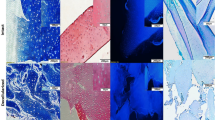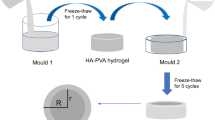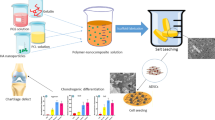Abstract
Biodegradable poly(ε-caprolactone) (PCL) has been increasingly investigated as a promising scaffolding material for articular cartilage tissue repair. However, its use can be limited due to its surface hydrophobicity and topography. In this study, 3D porous PCL scaffolds fabricated by a fused deposition modeling (FDM) machine were enzymatically hydrolyzed using two different biocatalysts, namely Novozyme®435 and Amano lipase PS, at varied treatment conditions in a pH 8.0 phosphate buffer solution. The improved surface topography and chemistry of the PCL scaffolds were anticipated to ultimately boost the growth of porcine articular chondrocytes and promote the chondrogenic phenotype during cell culture. Alterations in surface roughness, wettability, and chemistry of the PCL scaffolds after enzymatic treatment were thoroughly investigated using several techniques, e.g., SEM, AFM, contact angle and surface energy measurement, and XPS. With increasing enzyme content, incubation time, and incubation temperature, the surfaces of the PCL scaffolds became rougher and more hydrophilic. In addition, Novozyme®435 was found to have a higher enzyme activity than Amano lipase PS when both were used in the same enzymatic treatment condition. Interestingly, the enzymatic degradation process rarely induced the deterioration of compressive strength of the bulk porous PCL material and slightly reduced the molecular weight of the material at the filament surface. After 28 days of culture, both porous PCL scaffolds catalyzed by Novozyme®435 and Amano lipase PS could facilitate the chondrocytes to not only proliferate properly, but also function more effectively, compared with the non-modified porous PCL scaffold. Furthermore, the enzymatic treatments with 50 mg of Novozyme®435 at 25 °C from 10 min to 60 min were evidently proven to provide the optimally enhanced surface roughness and hydrophilicity most significantly favorable for induction of chondrogenic phenotype, indicated by the greatest expression level of cartilage-specific gene and the largest production of total glycosaminoglycans.








Similar content being viewed by others
References
Hunziker EB. Articular cartilage repair: basic science and clinical progress. A review of the current status and prospects. Osteoarthr Cartil. 2002;10:432–63.
Makris EA, Gomoll AH, Malizos KN, Hu JC, Athanasiou KA. Repair and tissue engineering techniques for articular cartilage. Nat Rev Rheumatol. 2014;11:21–34.
Niemeyer P, Andereya S, Angele P, Ateschrang A, Aurich M, Baumann M, et al. Autologous chondrocyte implantation (ACI) for cartilage defects of the knee: a guideline by the working group “Tissue Regeneration” of the German Society of Orthopaedic Surgery and Traumatology (DGOU). Z Orthop Unf. 2013;151:38–47.
Rönn K, Reischl N, Gautier E, Jacobi M. Current surgical treatment of knee osteoarthritis. Arthritis. 2011;2011:1–9.
O’brien FJ. Biomaterials & scaffolds for tissue engineering. Mater Today. 2011;14:88–95.
Portocarrero G, Collins G, Livingston Arinzeh T. Challenges in cartilage tissue engineering. J Tissue Sci Eng. 2013;4:e120.
Alvarez-Barreto JF, Shreve MC, Deangelis PL, Sikavitsas VI. Preparation of a functionally flexible, three-dimensional, biomimetic poly (L-lactic acid) scaffold with improved cell adhesion. Tissue Eng. 2007;13:1205–17.
Puppi D, Chiellini F, Piras A, Chiellini E. Polymeric materials for bone and cartilage repair. Prog Polym Sci. 2010;35:403–40.
Patel H, Bonde M, Srinivasan G. Biodegradable polymer scaffold for tissue engineering. Trends Biomater Artif Organs. 2011;25:20–9.
Cuddihy MJ, Kotov NA. Poly (lactic-co-glycolic acid) bone scaffolds with inverted colloidal crystal geometry. Tissue Eng Part A. 2008;14:1639–49.
Guarino V, Causa F, Taddei P, Di Foggia M, Ciapetti G, Martini D, et al. Polylactic acid fibre-reinforced polycaprolactone scaffolds for bone tissue engineering. Biomaterials. 2008;29:3662–70.
Jung Y, Park MS, Lee JW, Kim YH, Kim S-H, Kim SH. Cartilage regeneration with highly-elastic three-dimensional scaffolds prepared from biodegradable poly (l-lactide-co-ɛ-caprolactone). Biomaterials. 2008;29:4630–6.
Rohner D, Hutmacher DW, Cheng TK, Oberholzer M, Hammer B. In vivo efficacy of bone‐marrow‐coated polycaprolactone scaffolds for the reconstruction of orbital defects in the pig. J Biomed Mater Res B. 2003;66:574–80.
Salerno A, Di Maio E, Iannace S, Netti P. Tailoring the pore structure of PCL scaffolds for tissue engineering prepared via gas foaming of multi-phase blends. J Porous Mater. 2012;19:181–8.
Jiao Y-P, Cui F-Z. Surface modification of polyester biomaterials for tissue engineering. Biomed Mater. 2007;2:R24.
Zanetti NC, Solursh M. Induction of chondrogenesis in limb mesenchymal cultures by disruption of the actin cytoskeleton. J Cell Biol. 1984;99:115–23.
Solursh M, Jensen KL, Reiter RS, Schmid TM, Linsenmayer TF. Environmental regulation of type X collagen production by cultures of limb mesenchyme, mesectoderm, and sternal chondrocytes. Dev Biol. 1986;117:90–101.
Archer CW, McDowell J, Bayliss MT, Stephens MD, Bentley G. Phenotypic modulation in sub-populations of human articular chondrocytes. Vitr J Cell Sci. 1990;97:361–71.
Varghese S, Theprungsirikul P, Sahani S, Hwang N, Yarema K, Elisseeff J. Glucosamine modulates chondrocyte proliferation, matrix synthesis, and gene expression. Osteoarthr Cartil. 2007;15:59–68.
Costa Martínez E, Escobar Ivirico JL, Muñoz Criado I, Gómez Ribelles JL, Monleón Pradas M, Salmerón Sánchez M. Effect of poly(L-lactide) surface topography on the morphology of in vitro cultured human articular chondrocytes. J Mater Sci Mater Med. 2007;18:1627–32.
Le X, Poinern GEJ, Ali N, Berry CM, Fawcett D. Engineering a biocompatible scaffold with either micrometre or nanometre scale surface topography for promoting protein adsorption and cellular response. Int J Biomater. 2013;2013:1–16.
Cheng Z, Teoh S-H. Surface modification of ultra thin poly (ε-caprolactone) films using acrylic acid and collagen. Biomaterials. 2004;25:1991–2001.
Park JS, Kim J-M, Lee SJ, Lee SG, Jeong Y-K, Kim SE, et al. Surface hydrolysis of fibrous poly (ε-caprolactone) scaffolds for enhanced osteoblast adhesion and proliferation. Macromol Res. 2007;15:424–9.
Morent R, De Geyter N, Desmet T, Dubruel P, Leys C. Plasma surface modification of biodegradable polymers: a review. Plasma Process Polym. 2011;8:171–90.
Gümüşderelioğlu M, Kaya FB, Beşkardeş IG. Comparison of epithelial and fibroblastic cell behavior on nano/micro-topographic PCL membranes produced by crystallinity control. J Colloid Interface Sci. 2011;358:444–53.
Janvikul W, Uppanan P, Thavornyutikarn B, Kosorn W, Kaewkong P. Effects of surface topography, hydrophilicity and chemistry of surface-treated PCL scaffolds on chondrocyte infiltration and ECM production. Procedia Eng. 2013;59:158–65.
Uppanan P, Thavornyutikarn B, Kosorn W, Kaewkong P, Janvikul W. Enhancement of chondrocyte proliferation, distribution, and functions within polycaprolactone scaffolds by surface treatments. J Biomed Mater Res A. 2015;103:2322–32.
Kosorn W, Sakulsumbat M, Uppanan P, Kaewkong P, Chantaweroad S, Jitsaard J, Sitthisseripratip K, Janvikul W. PCL/PHBV blended three dimensional scaffolds fabricated by fused deposition modeling and responses of chondrocytes to the scaffolds. J Biomed Mater Res B. 2017;105:1141–50.
Kulkarni A, Reiche J, Hartmann J, Kratz K, Lendlein A. Selective enzymatic degradation of poly (ε-caprolactone) containing multiblock copolymers. Eur J Pharm Biopharm. 2008;68:46–56.
Peng H, Ling J, Liu J, Zhu N, Ni X, Shen Z. Controlled enzymatic degradation of poly (ɛ-caprolactone)-based copolymers in the presence of porcine pancreatic lipase. Polym Degrad Stab. 2010;95:643–50.
Zhang Y, Jiang N, Gan Z. In situ evaluation of cell cultivation on dynamically changed poly (ɛ-caprolactone) film caused by enzymatic degradation. Sci China Chem. 2011;54:369–74.
Banerjee A, Chatterjee K, Madras G. Enzymatic degradation of polymers: a brief review. Mater Sci Technol. 2014;30:567–73.
Gan Z, Liang Q, Zhang J, Jing X. Enzymatic degradation of poly (ε-caprolactone) film in phosphate buffer solution containing lipases. Polym Degrad Stab. 1997;56:209–13.
Blackwell C, Haernvall K, Guebitz G, Groombridge M, Gonzales D, Khosravi E. Enzymatic degradation of star poly (ε-caprolactone) with different central units. Polymers. 2018;10:1266.
Banerjee A, Chatterjee K, Madras G. Enzymatic degradation of polycaprolactone–gelatin blend. Mater Res Express. 2015;2:045303.
Zein I, Hutmacher DW, Tan KC, Teoh SH. Fused deposition modeling of novel scaffold architectures for tissue engineering applications. Biomaterials. 2002;23:1169–85.
Thavornyutikarn B, Chantarapanich N, Sitthiseripratip K, Thouas GA, Chen Q. Bone tissue engineering scaffolding: computer-aided scaffolding techniques. Prog Biomater. 2014;3:61–102.
Owens DK, Wendt RC. Estimation of the surface free energy of polymers. J Appl Polym Sci. 1969;13:1741–7.
Żenkiewicz M. Methods for the calculation of surface free energy of solids. J Achiev Mater Manuf Eng. 2007;24:137–45.
Zeng L, Yao Y, Wang D-a, Chen X. Effect of microcavitary alginate hydrogel with different pore sizes on chondrocyte culture for cartilage tissue engineering. Mater Sci Eng C. 2014;34:168–75.
Cortese B, Riehle MO, D’Amone S, Gigli G. Influence of variable substrate geometry on wettability and cellular responses. J Colloid Interface Sci. 2013;394:582–9.
Balmayor ER, Tuzlakoglu K, Marques AP, Azevedo HS, Reis RL. A novel enzymatically-mediated drug delivery carrier for bone tissue engineering applications: combining biodegradable starch-based microparticles and differentiation agents. J Mater Sci Mater Med. 2008;19:1617–23.
Boyan BD, Hummert TW, Dean DD, Schwartz Z. Role of material surfaces in regulating bone and cartilage cell response. Biomaterials. 1996;17:137–46.
Noriega SE, Hasanova GI, Schneider MJ, Larsen GF, Subramanian A. Effect of fiber diameter on the spreading, proliferation and differentiation of chondrocytes on electrospun chitosan matrices. Cells Tissues Organs. 2012;195:207–21.
Acknowledgements
The authors would like to acknowledge Professor Supapan Seraphin from professional authorship center (PAC), National Science and Technology Development Agency (NSTDA), Thailand for useful discussions. This research was financially supported by the National Metal and Materials Technology Center (MTEC), Thailand (project code: MT-B-57-BMD-07-209-I).
Author information
Authors and Affiliations
Corresponding author
Ethics declarations
Conflict of interest
The authors declare that they have no conflict of interest.
Additional information
Publisher’s note Springer Nature remains neutral with regard to jurisdictional claims in published maps and institutional affiliations.
Supplementary information
Rights and permissions
About this article
Cite this article
Kosorn, W., Sakulsumbat, M., Lertwimol, T. et al. Chondrogenic phenotype in responses to poly(ɛ-caprolactone) scaffolds catalyzed by bioenzymes: effects of surface topography and chemistry. J Mater Sci: Mater Med 30, 128 (2019). https://doi.org/10.1007/s10856-019-6335-6
Received:
Accepted:
Published:
DOI: https://doi.org/10.1007/s10856-019-6335-6




